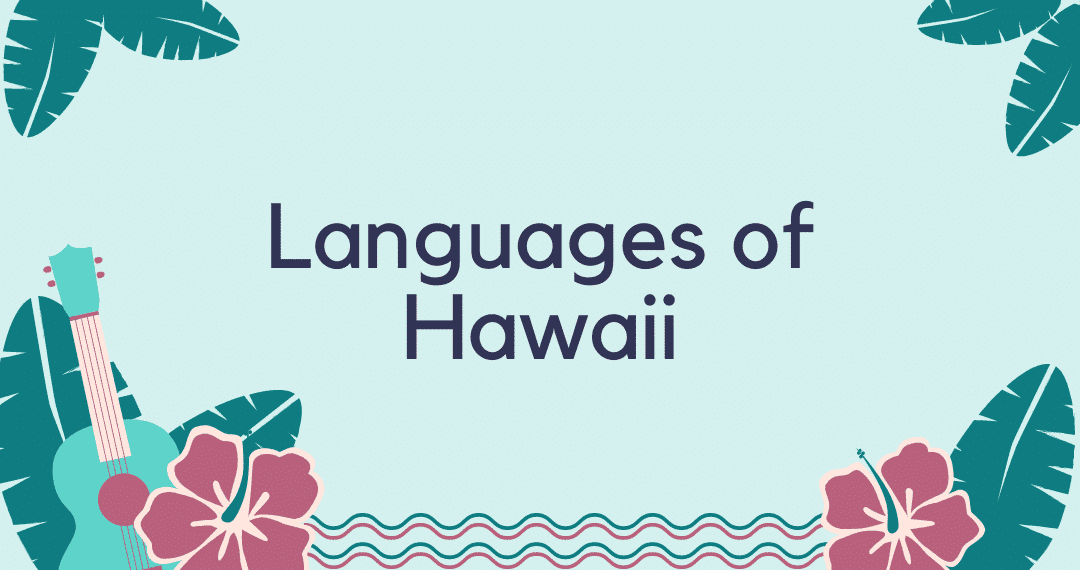Hawaii is a subtropical paradise in the Pacific Ocean. It is also the only US state that is not a part of the North American continent.
While there are only 1.4 million people living in Hawaii, it’s among the most densely populated American states.
What’s more, Hawaii is a melting pot of languages and cultures. Linguists have estimated that there are about 130 languages spoken in Hawaii. Even more astonishing is the diverse origin of these languages.
There are European languages such as Portuguese and Spanish, and Asian languages such as Tagalog, Japanese, Chinese, etc. The indigenous language, Hawaiian, can also be heard in some of the Islands.
Keep reading to explore the languages of Hawaii!
Location and history of Hawaii
Hawaii or the Hawaiian Islands, an archipelago of eight major islands (Niihau, Oahu, Kauai, Lanai, Maui, Molokai, Kahoolawe, and the Big Island of Hawaii) is a part of the Polynesian subregion of Oceania.
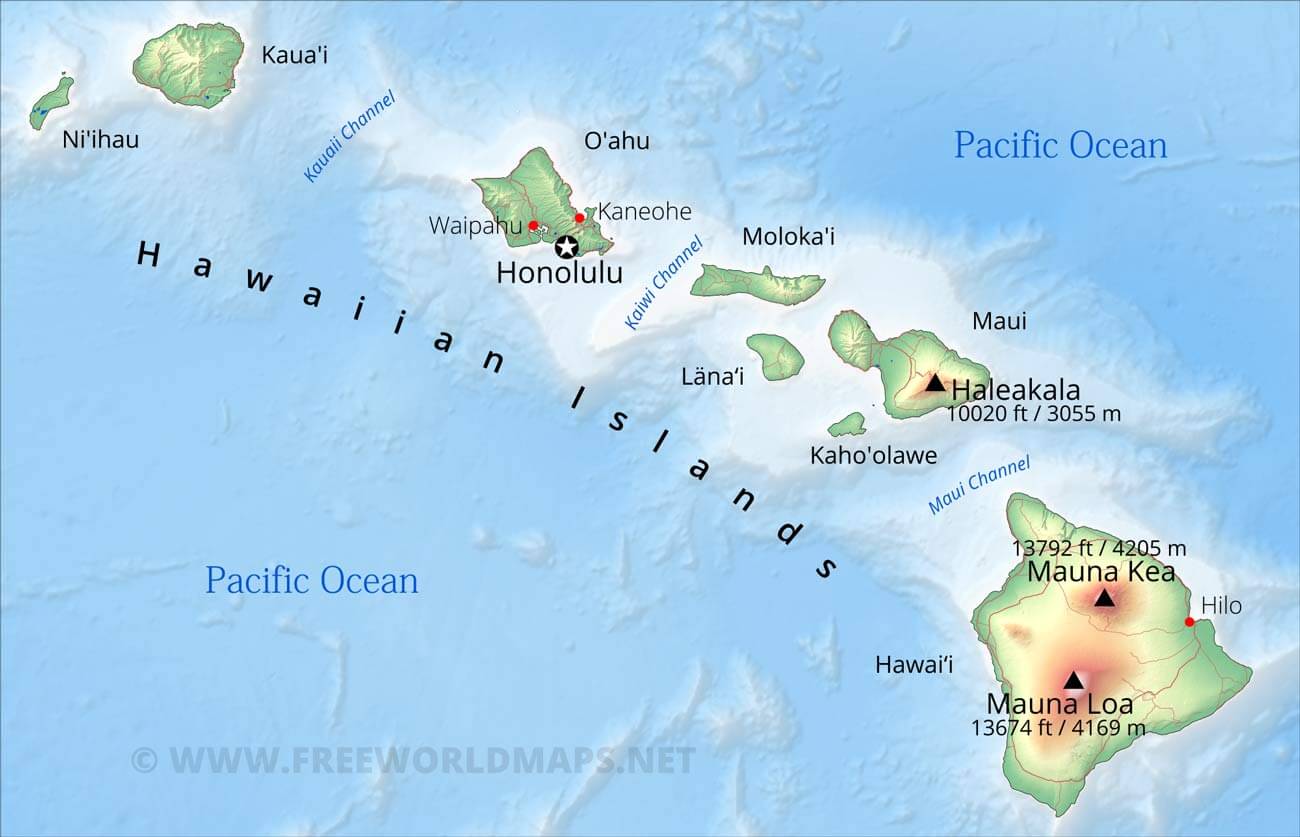
As mentioned before, this is the only US state that is not geographically connected to North America. What’s more, the Islands are situated 3,000 km (1,860 miles) away from the nearest continent.
Interestingly, the Hawaiian Islands are exposed peaks of a massive undersea mountain range, also known as the Hawaiian–Emperor seamount chain, which was formed by volcanic activity.
In the past, Hawaii was known as the Sandwich Islands, a name given by James Cook in honor of the 4th Earl of Sandwich. In the 1840s, the American state was renamed after its biggest island, the Big Island of Hawaii.
The population of the Hawaiian Islands
In 2021, the population of Hawaii was estimated to be 1.44 million.
According to US 2020 Census, people of European descent are about 357,308 (29.4%), while African Americans are 25,884 (2.1%). They come from Sub-Saharan African people, Kenyan, Nigerian, and the Caribbean such as Haitian and Jamaican.
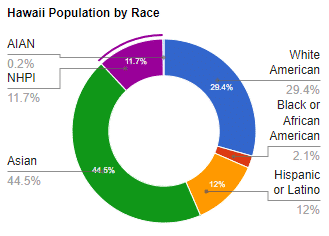
The Asian population on the Hawaiian Islands is the biggest ethnic group with 540,556 people (44.5%), with huge Chinese, Filipinos, Japanese, Korean and Vietnamese communities living on the Islands.
Around 145,381 Hawaiian inhabitants (12%) belong to the Hispanic population. The biggest Hispanic communities come from Mexico, Puerto Rico, and Cuba.
Native Hawaiians are estimated to be 88,969 people.
Also read: Spanish Localization: Should You Localize Into LA or European Spanish
Linguistic/cultural history of Hawaii
The first settlers on the Hawaiian Islands came as early as 400 C.E. from the Marquesas Islands. They were highly skilled fishermen and farmers and lived in small communities, which were constantly fighting over territory.
In 1778, James Cook was the first European to set foot on Hawaii, as he reached the island of Kauai.
Between 1791 and 1810, King Kamehameha, the first Hawaiian king who is still cherished and celebrated every June 11, King Kamehameha Day, conquered and united the entire archipelago into one kingdom.
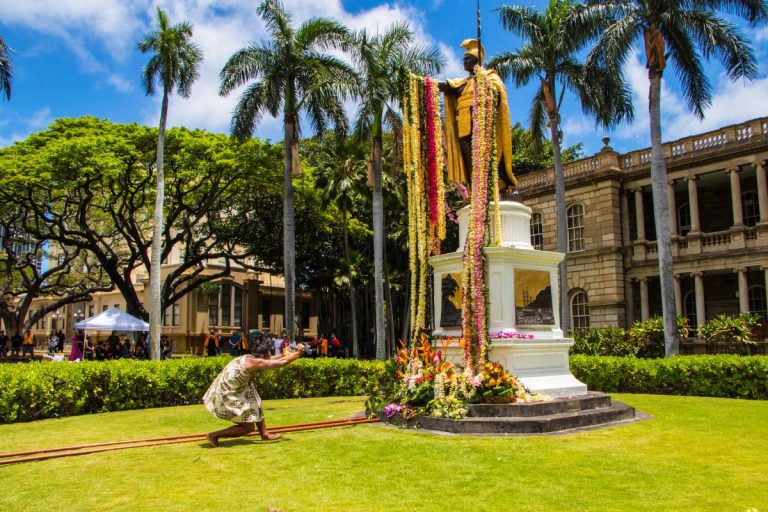
During the 1820s, Christian missionaries, whalers, and Western traders arrived on the Islands, bringing diseases that were deadly to the indigenous Hawaiian population.
In 1893, American colonists overthrew the kingdom and established the Republic of Hawaii. The Hawaiian sugar-based economy came under their control. In 1898, the U.S. annexed Hawaii as a territory.
On August 21, 1959, Hawaii becomes the 50th state in the United States of America after a popular vote.
Nowadays, the Big Island is a buzzing center of both education and research. It is also home to one of the University of Hawaii’s campuses in Hilo.
The main research objectives of this institution are astronomy, alternative energy (wind power, geothermal, etc.), ocean research, and much more.
With its beautiful beaches, tourism accounts for a large portion of the state’s annual revenue.
In addition, the well-developed agriculture in the Islands, including crops such as flowers (especially orchids), coffee, and macadamia nuts, is yet another sector that brings significant annual revenue.
Also read: Everything About The Languages Of APAC
What are the Languages spoken in Hawaii?
English, Hawaiian, and Hawaiian Creole English (more commonly known as Pidgin) are the most widely spoken languages in Hawaii.
The Hawaiian Constitution recognizes as official languages, both English and Hawaiian, but not Pidgin. This makes Hawaii the only state that has two official languages.
The Hawaiian language
Hawaiian or Olelo Hawai’i is a Polynesian language. What’s more, the Hawaiian language is spoken by less than 6% of the local population.
Interestingly, from Hawaii to New Zealand all island nations speak a Polynesian-based language variation. However, these variations are unique for each island nation and thus, speakers of different variations find it difficult to understand each other.
Also read: Language vs Dialect vs Accent: What is the Difference?
In 1896, the Hawaiian government stopped education in Hawaiian. This led to a severe decline of the Hawaiian speakers since people had no need to use the language in their daily lives.
At one point in 1985, only 32 children under the age of 18 on the Islands spoke the Hawaiian language.
As a result, linguists were even concerned that the Hawaiian language would fade away, never to be spoken again.
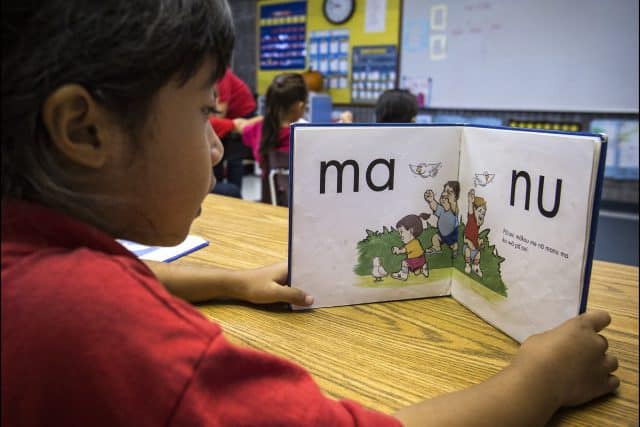
Some accounts claim that the Hawaiian language was even outlawed. Thus, people, who spoke it, went to prison. However, these claims were never proven to be right,
In modern times, thanks to the state government’s efforts, the Hawaiian language is still alive. Even though most inhabitants of the islands don’t speak it, the Hawaiian language has remained central to the Hawaiian traditions and culture, which has been passed down for centuries from one generation to the next.
The Hawaiian Creole or Pidgin
The Hawaiian Creole, also known as Pidgin, is a mix of primarily English, Hawaiian, Chinese, Indonesian, Japanese, and Portuguese.
Also read: Portuguese vs Spanish – Is Spanish Similar to Portuguese
The Pidgin developed as a result of the arrival of numerous foreigners to the Hawaiian Islands. Most of them were agricultural day laborers.
In order to achieve successful communication in less time, the foreigners combined easy-to-remember words and expressions from the various languages spoken among the people of the Islands.
Of course, English and Hawaiian were the dominant languages in Hawaii, so they had the greatest influence on the Pidgin.
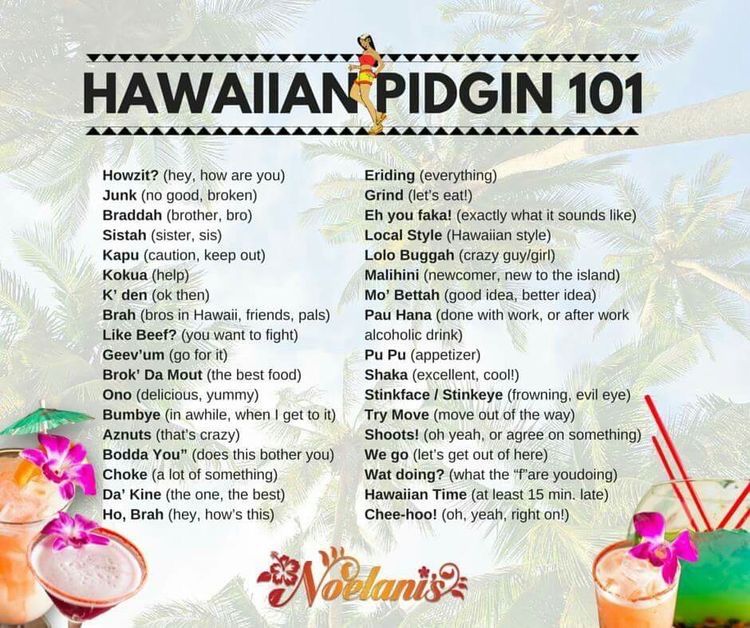
Since pidgin is not recognized as a language, there are no statistics about its speakers. Still, locals claim that on some islands, Pidgin is even more widely spoken than English or Hawaiian.
The Hawaiian language vs Pidgin
As mentioned before, Hawaiian is officially recognized by the state, while Pidgin is not.
This is an interesting occurrence, having in mind that Hawaiian is spoken by only a few thousand people on the island. In contrast, Pidgin is allegedly used by hundreds of thousands on a daily basis as a means of communication.
This is why some people confuse the two terms. They often refer to Pidgin as the Hawaiian language, since it is so widely spoken on the islands.
Also read: What are the fastest growing languages?
Other languages spoken in Hawaii
Hawaii is home to many cultures and languages. One of the reasons for this unique linguistic variety is migration.
During the 1900s, a large influx of immigrants arrived in the Hawaiian Islands. These were mainly people seeking a better life. The Hawaiian Islands offered working opportunities on huge sugar and pineapple plantations.
All of these immigrants brought to the islands their own languages, traditions, and cultures. They formed communities that remain today. Thus, it is very common to hear other languages on the Hawaiian Islands, such as:
- Chinese (Mandarin and Cantonese)
- Filipino
- Korean
- Japanese
- Vietnamese
- Thai
- Samoan
- Austronesian
- Lao
- Khmer
- Tagalog
- Ilocano
- Portuguese
- Spanish
Overall, there are 100+ languages spoken by the residents of Hawaii.
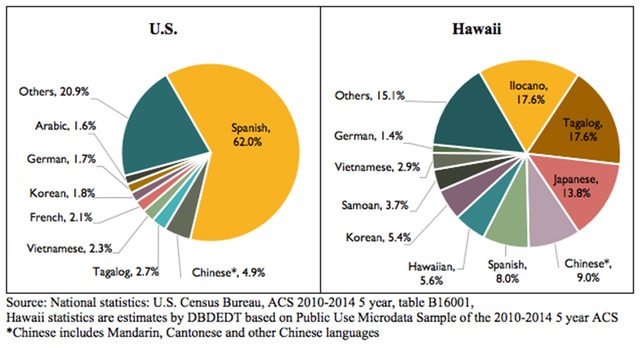
Also read: Languages of Philippines: Everything You Need to Know
Grow your business in APAC with language translation
We provide professional translation and localization services in Chinese, Japanese, Hindi and 70+ languages.
Is English spoken in Hawaii?
Without a doubt, English is the dominantly spoken language in the Hawaiian Islands.
However, you should keep in mind that the English spoken in Hawaii has its own peculiarities. Indeed, the Hawaiian language and the local Pidgin have had a great deal of influence on the English spoken there.
As a result, there are a number of words and expressions that are typically local. What’s more, a number of English words have different pronunciations and spelling.
For example, Hawaiian residents call themselves Kama’aina (which means “child of the land” in Hawaiian). Hawaiian, on the other hand, is used to refer to a specific ethnicity on the islands.
When it comes to the distribution of the English language on the Hawaiian Islands, it is definitely the most widely spoken language on the Island. Of course, the Hawaiian language is still spoken by some Hawaiian families at home.
What’s more, on the privately owned Island of Niihau people primarily speak Hawaiian in an attempt to preserve the local language and culture.
Still, the rest of the Hawaiian Islands speak American English. In addition, English is the main language of instruction at schools and is used by the media, government, and locals on a daily basis.
Also read: Top Languages Spoken in California
Conclusion
Hawaii’s linguistic diversity is often overlooked. Indeed, in this subtropical paradise one can hear a number of different languages, such as Chinese, Filipino, Tagalog, Spanish, etc.
If you want to expand your business in the Hawaiian market, consider translating your content with professional translation services to attract and engage the people of Hawaii.
Without a doubt, English is the most widely spoken language in the Hawaiian Islands, but still, you might be surprised by how different it sounds. In fact, words and phrases from the indigenous Hawaiian languages are often sprinkled in the local people’s everyday language.
And while Hawaiian is used only by a small part of the local population, it has left its mark on the English spoken on the islands.
Also read: Languages of East Asia
Grow your business in APAC with language translation
We provide professional translation and localization services in Chinese, Japanese, Hindi and 70+ languages.

